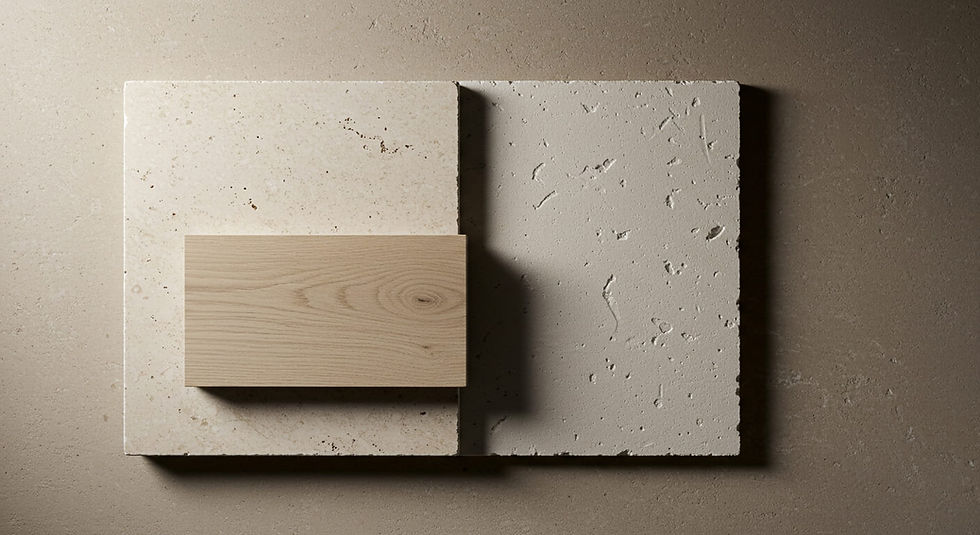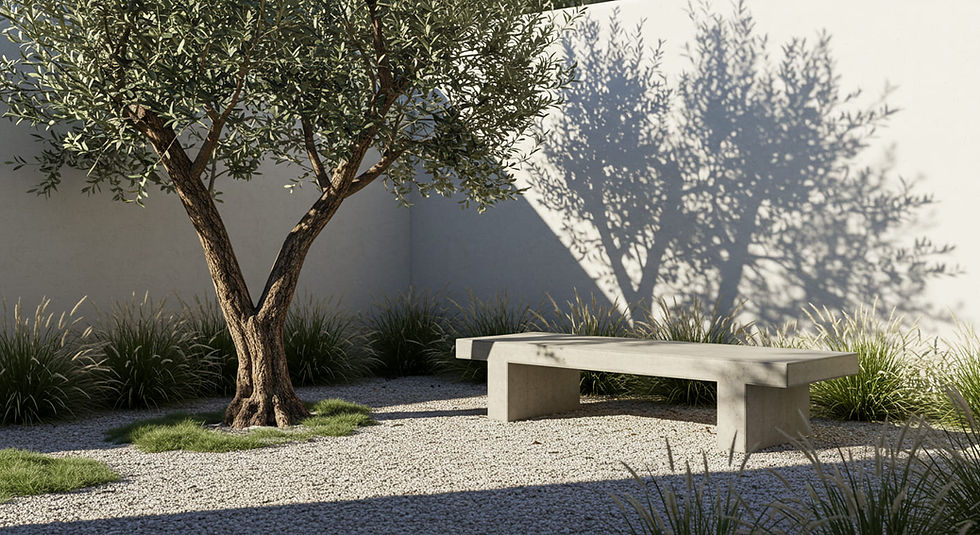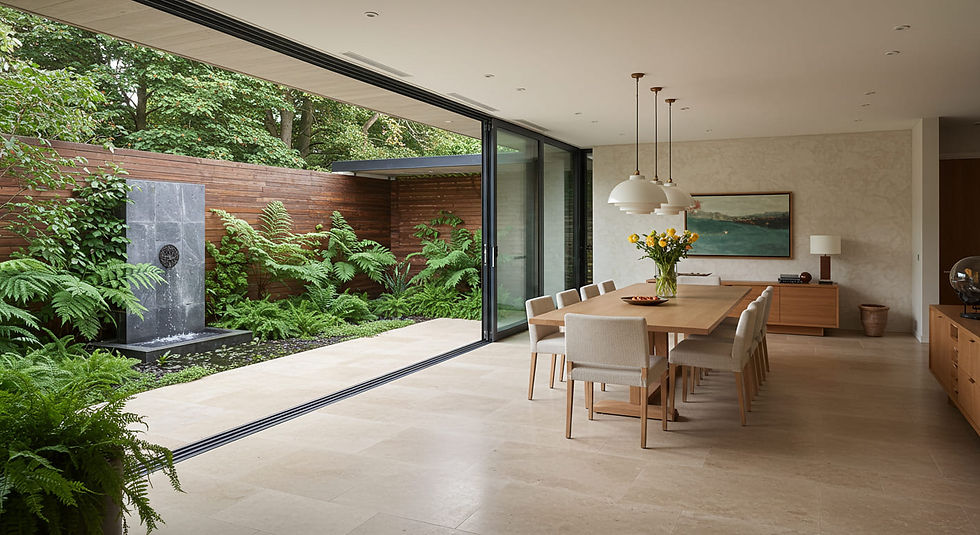
Organic Contemporary
Where natural honesty meets architectural clarity.
The Philosophy of Organic Contemporary
Organic Contemporary is not merely a style; it is an ethos. It is a response to our digitally saturated world, offering a return to the tactile, the authentic, and the serene. This approach softens the clean lines of modernism with natural materials, sculptural forms, and an unwavering connection to the landscape. The goal is to create a sanctuary—a space that feels both elemental and elevated, grounded and expansive. It is a quiet luxury, defined by the quality of its materials and the tranquility it inspires.
The Design Principles of Organic Contemporary
Every aesthetic is a composition, built upon four fundamental principles of design. Here is how Organic Contemporary utilizes Form, Pattern, Color, and Light to create its signature atmosphere.
Form & Geometry

Form in this aesthetic moves away from rigid orthogonality. It favors soft, sculptural shapes, curved walls, and arched openings that encourage flow and a sense of ease. Furniture is defined by generous, rounded silhouettes. The geometry is present but softened, referencing the organic shapes found in nature rather than the strictness of the machine.
Form & Geometry Tags
Geometric Language
Curvilinear & Sculptural
Level of Articulation
Monolithic & Seamless
Surface Character
Soft & Hand-Formed
Pattern & Applications

Pattern is inherent, not applied. It is discovered in the subtle veining of honed stone, the natural grain of rift-sawn oak, or the gentle movement of a plaster wall. This aesthetic avoids decorative prints, instead finding its visual interest in the authentic, unadorned texture of its core materials, creating a rich yet understated sensory experience.
Pattern & Application Tags
Pattern Source
Organic
Pattern Structure
Random & Allover
Pattern Character
Minimal & Subtle
Color & Tone

The palette is drawn directly from the earth: the warmth of bone and sand, the soft grey of stone, the deep umber of rich soil. It is a tonal, monochromatic narrative that creates a cohesive, calming envelope. Accent colors are muted and derived from nature—mossy greens, faded terracotta—used with restraint to maintain a serene atmosphere.
Color & Tone Tags
Palette Category
Tonal & Serene
Signature Palette
The Minimalist's Edit
Secondary Palette
The Monochromatic
Light & Atmosphere

Light is treated as a primary material. The design maximizes natural, diffused light through large, unadorned apertures, creating a soft, ethereal glow that connects the interior to the day's cycles. Artificial lighting is layered, warm, and indirect, designed to create intimate pools of light that enhance the architectural forms and materials.
Light & Atmosphere Tags
Primary Light Source
Natural & Fenestration
Architectural & Integrated
Light Quality
Soft & Diffused
Light Temperature & Tone
Warm, Inviting, or Natural
The Signature Organic Contemporary Component Palette
This is the tangible vocabulary of the aesthetic. The organic contemporary material palette is a curated collection of authentic, sensory elements that bring the design principles to life. Understanding these signature components is key to grasping the core characteristics of organic contemporary style—a serene vision built from honest materials.

Architectural Surfaces & Finishes
As the foundational canvas, architectural surfaces define the serene, monolithic envelope of the aesthetic. The focus is on tactile honesty and soft, matte textures that absorb and diffuse light, creating a calm, immersive environment that engages the senses rather than simply being observed.
Limewash & Plaster: Applied by hand, these finishes provide a subtle, velvety movement that turns walls into sculptural, touchable surfaces.
Light Woods: Rift-sawn white oak and ash introduce warmth and organic pattern through their natural grain, grounding the space with an honest connection to nature.
Honed Stone: Travertine and limestone with a soft, matte finish are chosen for their earthy quality, connecting the interior directly to the geological world.
Apertures & Architectural Passages
Openings are treated not as interruptions, but as sculptural forms in their own right. By forgoing traditional trim and casings, passages become soft, arched, or clean-lined apertures that maximize the flow of natural light and create seamless, graceful transitions between spaces.
Frameless Openings: Doorways and passages are often finished with a simple radius edge, blending directly into the plaster walls to maintain a monolithic feel.
Minimalist Glazing: Expansive floor-to-ceiling glass with minimal framing is used to dissolve the boundary between inside and out, making the landscape a primary feature.


Fixtures, Hardware & Integrated Systems
The approach to fixtures prioritizes timeless materials and seamless functionality. Simple, elegant forms are favored, often in "living finishes" that develop a natural patina over time. Technology and systems are discreetly integrated, designed to be felt and experienced, but rarely seen.
Living Finishes (Brass/Bronze): Unlacquered brass and bronze are used for their warmth and inherent character, evolving over time to add a layer of soulful history to the space.
Matte Black Accents: Used with restraint for hardware or plumbing fixtures, matte black provides a point of graphic contrast that grounds the softer, natural palette.
Furnishings & Textiles
Furnishings introduce softness and tactile comfort, balancing the architectural rigor of the space. Forms are generous and sculptural, upholstered exclusively in natural fibers that invite touch. These pieces are chosen to be both beautiful objects and sources of profound comfort.
Sculptural Upholstery: Sofas and chairs often feature soft, curved silhouettes and monolithic forms, acting as comfortable sculptures within the room.
Natural Fibers (Linen/Wool): Heavy Belgian linen, rich wool, and textural bouclé provide visual softness and a luxurious, tactile experience.
Handmade Ceramics: Artisanal vessels with matte, sandy glazes are used as organic, sculptural accessories that reinforce the aesthetic's connection to craft.


Flora, Landscape & Hardscape Elements
For organic contemporary homes in Los Angeles, the exterior is treated as a seamless extension of the interior. The landscape design aims to create a serene and immersive environment, blurring the lines between the natural and built worlds. It's a holistic approach that ensures the entire property tells a single, cohesive design story.
Signature Flora: Sculptural, mature olive trees provide timeless form, while soft ornamental grasses like Mexican Feather Grass add gentle movement and texture.
Elemental Hardscapes: Honed travertine pavers create soft, tactile surfaces underfoot, while decomposed granite paths offer a textural contrast for a natural feel.
Architectural Features: Board-formed concrete fire pits and negative-edge pools are designed as integrated architectural elements that extend the home's structure into the garden.
The Rules of Composition
Contrast & Hierarchy
Contrast is subtle and textural, not chromatic. The interplay between a smooth plaster wall and a rough-hewn wooden beam, or a soft linen sofa on a hard stone floor, creates a quiet dynamism. Hierarchy is established through scale and form—a monolithic kitchen island or a single, sculptural armchair becomes a serene focal point.
Visual Weight
The aesthetic creates a profound sense of grounding. Visual weight is concentrated low to the ground with solid, heavy forms and materials. This is balanced by an atmosphere of lightness and air above, achieved through high ceilings, ample natural light, and a restrained upper material palette, fostering a feeling of simultaneous security and expansiveness.
Further Reading: A Design Journal
The Art of the Unseen:
Integrating Technology into a Serene Home
A truly serene space is also intuitively functional. This journal entry deconstructs the complex process of seamlessly integrating state-of-the-art smart home technology—from architectural lighting to invisible speakers—without compromising the clean lines and tactile honesty of an Organic Contemporary interior.

Understanding the Aesthetic's Subtleties
The Defining Element
Organic Contemporary's defining element is its use of soft, sculptural forms. It trades the strict geometry of modernism for gentle curves, arched openings, and monolithic shapes that feel hand-formed, creating an environment that is serene and soulful, not just rational.

%20A%20luxurious%20California%20Modern%20living%20room%20at%20dusk%20with%20an%20open%20glass%20wall%2C%20teak%20ceilin.jpg)
%20A%20serene%20Japandi%20living%20room%20with%20a%20beige%20boucl%C3%A9%20sofa%2C%20a%20fluted%20oak%20wall%2C%20and%20a%20black%20.jpg)